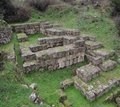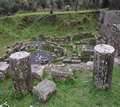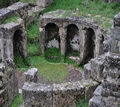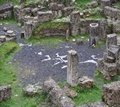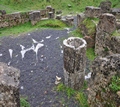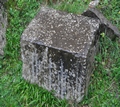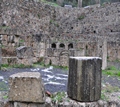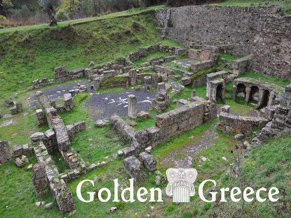
Ancient Gortys was an important Arcadian city during antiquity. According to mythology, the ancient city was built by Gortys, son of Stymphilos and great-grandson of King Arcada. The town and the Lousios river, which from ancient Gortyna to its confluence with the Alpheios, are named Gortynias river, were named after its founder. The ancient city was built right next to Lousio, at an altitude starting at 340 m. The city had a sanctuary of Asklepios - Asklepiio, large thermal baths - both famous throughout the Peloponnese - two strong fortified enclosures (citadels), other sacred and public buildings. Bath therapy was also here directly connected to the cult of Asclepius. Its citadels date from the 4th BC. h. and they had a great and strong wall. They were close to each other, at an altitude that reaches 480 m., south of the temple of Asklepios and the thermal baths. The main one was about 425 m long and 100-160 m wide, and had three gates.
The archaeological finds from the area are dated from the Geometric years up to the Byzantine period and demonstrate an important cultural activity over a long period of time, mainly in the Classical and Hellenistic eras. The most important period of the ancient city's heyday can be found in the 4th BC. century. Also the excavations showed that the city was destroyed in the 2nd AD. century. From Gortyna passed the ancient road of Olympia - Megalopolis - Mycenae - Isthmus - Athens that led to ancient Olympia. The Spartan athletes on their way to Olympia for the Olympic Games also passed through here.
Until today, it has not been possible to determine the chronologies of the foundation, heyday and decline of Gortynos. This is due on the one hand to the minimal written testimonies and reports of the Ancient Greek Secretariat, but also to the few archaeological findings of the excavations. Therefore, the opinions of the researchers on this subject differ. However, the existing evidence shows that it is a very ancient city with a long and important history in antiquity. Its foundation should be sought in a large time spectrum extending from the Late Helladic Period (1600-1100 BC), when the Mycenaean Civilization flourished, up to the Geometrical Period (11th-8th century BC). Its heyday is placed in the Archaic Period (8th-early 5th century BC), in the Classical Era (478-323 BC), even in the Hellenistic Era (323 BC- 30 AD .).
The historical development of the city is interwoven with the history of its wider area, which includes critical phases and rearrangements such as the participation of the ancient Arcadian cities in the area of present-day Gortynia in the Trojan War, the spread of the Dorians in the Peloponnese (11th-10th centuries. BC), the first and second colonization (11th-8th & 8th-6th centuries BC) which forced the Arcadians to migrate to distant regions, the founding of Megalopolis (368 BC), the Roman conquest, and finally the events of the Byzantine period.
However, according to several researchers, Gortys was founded in the second half of the second millennium BC. This in fact results from its association with the ancient Gortyna of Crete which is located southwest of the city of Heraklion, in the Mesara plain. This city is said to have been founded by inhabitants of the first. According to written testimonies, the ancient traveler Pausanias mentions in his work Tour of Greece that in the city there was a temple of Asclepius which was decorated with cult statues of Asclepius and Hygia, made of Pentelic marble, works of the Parian sculptor Scopas. It also mentions that when Alexander the Great (356-323 BC) descended on the Peloponnese, he passed through Gortyna to worship, dedicating his armor and spear to the temple.
Source: UNIVERSITY OF PATRAS
arcadia.ceid.upatras.gr









